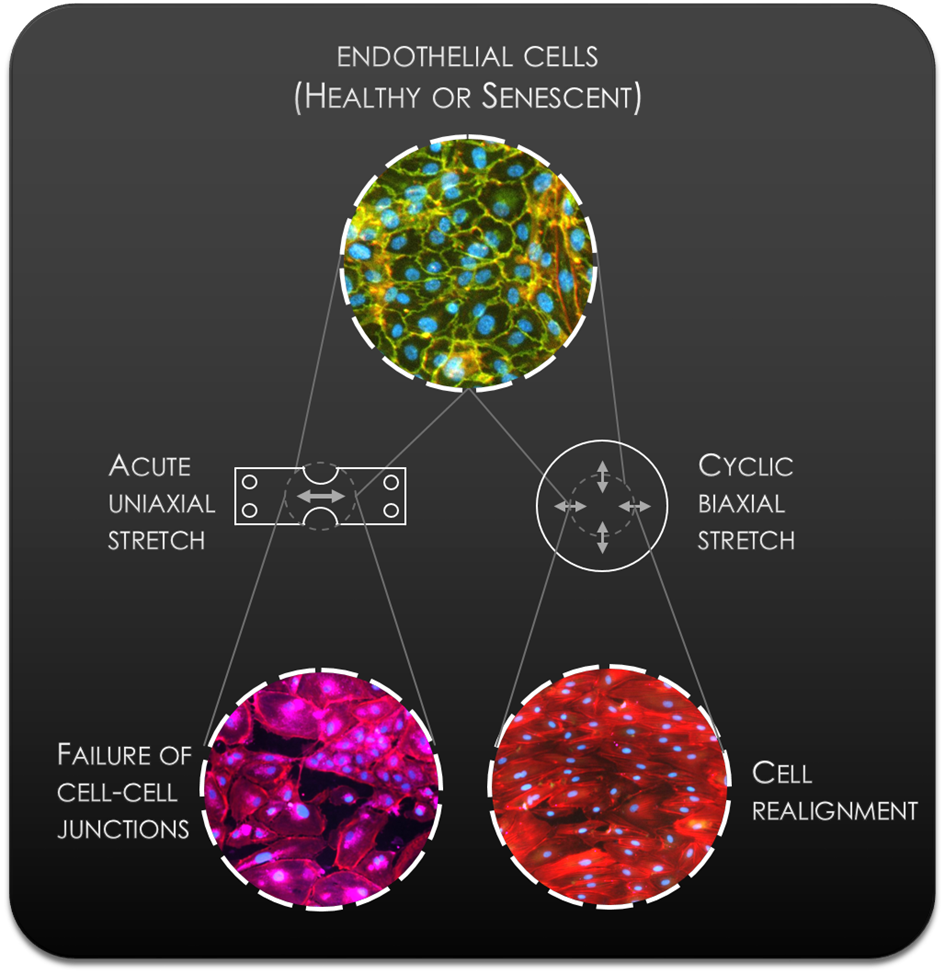Endothelial Monolayer Response to Stretch and the Role of Senescence
The endothelium—a single-cell thick, continuous layer of endothelial cells—covers the internal surfaces of all our blood and lymph vessels. Endothelial cells (ECs) play a critical role in maintaining homeostasis, vascular tone, immune response, thrombosis, and permeability. ECs are subjected to different mechanical forces such as stretch due to blood flow pulsatility. Endothelial function decays progressively with age and growing evidence has shown that endothelial cell senescence has a causative role in the progression of age-related disorders such as cardiovascular diseases and atherosclerosis. How senescence affects the endothelial response to mechanical stretch on a tissue and cellular scale remains uninvestigated.
In this research project, experimental systems will be developed and used to investigate normal and senescent endothelial monolayer response to stretch using in-vitro, ex-vivo, and/or in-vivo experimental models. The findings from this project will provide mechanobiological insight into EC collective behavior, and, how senescence alters this behavior. Additionally, as we evaluate what levels of stretch the endothelium begins to be damaged, we can begin to define engineering constraints for designing endothelialized stretchable materials.
Specifically, endothelial monolayers will be grown on elastomeric substrates and subjected to either acute/short-term stretch or cyclic/long-term stretch. The specific aims for this project include: 1) Development of novel stretch systems, 2) Short-term stretching experiments, 3) Long-term stretching experiments, and 4) Ex- or in-vivo stretch experiments.
Novel stretching devices have been and are being developed for applying different modes of stretch to a healthy or senescent endothelium. With these stretch systems, either short- or long-term stretch regimes can be applied (Figure 1). While acute/short-term stretch is intended to reveal passive material behavior of the EC monolayer and the ultimate levels of stretch that the cellular material can withstand, the long-term/cyclic is intended to reveal active material behavior as the EC monolayer is provided sufficient time to adapt the mechanical loading. Computational models for cell-substrate and cell-cell interactions can subsequently be developed using these data. As a final step, we aim to develop experimental approaches to investigate stretch ex- or in-vivo to characterize physiological endothelium. By studying the endothelium in a physiologically relevant model, we can better understand how the endothelium behaves in-situ and how this behaviour diverges from EC monolayers cultured on synthetic elastomeric substrates.
This work is part of the Zurich Heart project under the umbrella of University Medicine Zurich/Hochschulmedizin Zürich, as well as the ETHeart research initiative in collaboration with Prof. Dr. Volkmar Falk and Dr. Nikola Cesarovic from the Deutsches Herzzentrum Berlin.

Project Lead

Young Choi